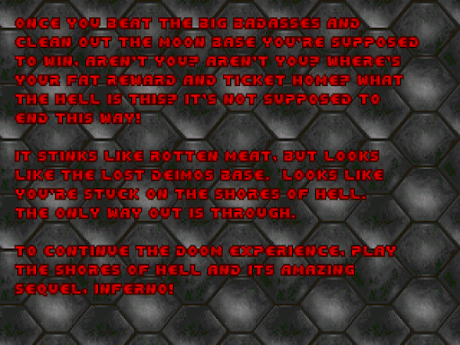DOOM
1.What is the name of the game?
DOOM.
2. Does the game have a narrative?
Yes, although there is very little content in game about it. The narrative is mainly just the sequence of the character fighting monsters and zombies on different parts of a military base and ultimately, hell. It consists of 4 main episodes that take place on Mars' moons, hell, and then end with an invaded Earth (to be continued in DOOM II). In between each episode, a brief text screen is displayed to provide some exposition before gameplay starts up again. A detailed background is given in the physical instruction manual that came with the game.
3. How does the game negotiate the aesthetics of choice with its narrative?
The only goal of each episode is to make it to the teleporter at each base to travel to them one by one. Other than survival, there are no objectives. However, you do encounter many enemies and get to swap between multiple weapons throughout gameplay, collecting them as you progress. You can choose whether to kill the enemies or just get out of range. You can swap between guns or stick with your fists. There is armor you can collect to protect your health as well as med packs that increase your health. Ammo is also finite and needs to be collected to continue using the guns. It is possible to speedrun levels, go back whenever, or fully complete every level 100%. Choosing to explore each map in full will allow the player to find hidden areas with bonuses and weapons. The narrative stays the same the entire time, so the choice aspect comes in more with how the individual player plays each level. You can select which episode to play as well, meaning the game does not need to be played chronologically to unlock episodes. The difficulty is also adjustable, which affects the gaming experience.
4. Rate the game’s difficulty along the mechanical, interpretative, and affective axes, giving reasoning for each.
I would rate the mechanical difficulty as pretty high, 8/10. Even on the easiest difficulty, you need to have some experience with fast-paced gaming, consciously manage your resources, and be able to aim and shoot at enemies while minimizing personal damage. The higher the difficulty, the more mechanical skill is necessary.
For interpretative difficulty, I rate it pretty low, 3/10. The storyline is very straightforward and simple, free of symbolism and ambiguity. At times, it can be tricky to navigate the labyrinthian military bases without a map. You need to keep track of where you have been to ensure you are progressing closer to the exit. It is often tricky to navigate and you need to understand the puzzle aspect of the many sliding doors and elevators, especially when you are dropped in a pitch black room and need to kill enemies and find a way out without being able to see.
As for affective difficulty, it was in the middle, 6/10. I thought the visuals and sound effects were pretty funny, especially the oddly wet squelch noise the monsters made when you killed them. It was graphic though, with bloody corpses everywhere and piles of monster guts, although the quality is so low that they're not detailed whatsoever. Maybe for some people, it could be too scary or intense, especially the "jump scares" and enemies hidden at every corner, often rushing at you. It does build up a good amount of tension, primarily doing so through the atmosphere of the environments, using lighting and sounds, as well as music that is more fast paced. It could possibly anger or frustrate someone, especially on higher difficulties, as it is a game that requires maintaining your full focus and acting fast. At the end of each level, you do get your stats and the closer to 100% and lower the time, the more rewarding the level feels.
5. How does the game handle failure?
I liked how the game handled failure. It was tricky to figure out all the controls at first and how to navigate the map so it was no surprise when I had 1% health by the end of the first level. Luckily, when I died in the second level, I was just sent back to where the level started and given both full health and 50 bullets, but armor goes back to 0%. The game doesn't prevent you from progressing if you die and sets you up with enough resources to make an easy recovery. Any enemies already killed will not respawn. You can easily repeat a level over and over until you complete it. However, what I didn't realize because I died so early, was that you lose any weapons or items you collected. You only respawn with the default gun. It does not have an autosave feature, so it is important to manually save throughout or lose your progress.
6. What did you like best and least about the game
I liked the concept. I thought it was cool and liked solving the challenges of each map. It's fun to play a game where the environment changes so frequently. I was never bored and always discovering new puzzles and ways to navigate. Taking out the enemies was fun, especially once I got better weapons and could easily 1-shot them from a distance. I do wish there was more story because what I found out online was a deeper plot that gave more insight into the unnamed protagonist. The text screens are fine, but maybe a sequence before gameplay that explained what happened would have made it more immersive. As it is, you feel really disconnected from the character you play as, who has no distinct personality, no dialogue, and no name. Having to remember to manually save can also be frustrating and set you back.






Comments
Post a Comment